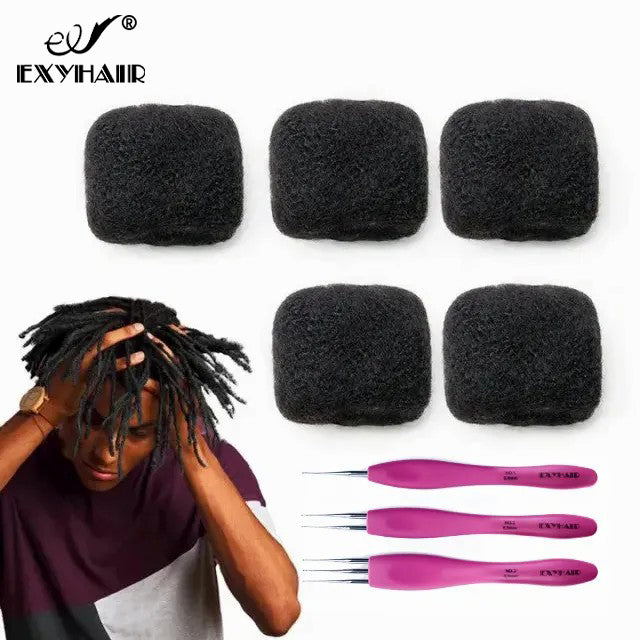Microlocs What Type of Locking Method Is Best for Your Hair

Looking to start microlocs but not sure which locking method is right for you?
Microlocs have become an increasingly popular protective style for people with natural hair. They provide the neat, uniform look of sisterlocks but offer more freedom in terms of installation method, maintenance routine, and personal customization. Choosing the right locking method is key to starting your microlocs journey on the right foot.
What Are Microlocs?
Microlocs are small, uniform dreadlocks typically smaller than traditional locs but slightly larger than sisterlocks. They are usually installed without the need for a certified consultant and can be started using several different methods.
Benefits of Microlocs
- Greater styling flexibility
- Lower installation cost than sisterlocks
- Can be DIY or professionally installed
- Scalp is more visible and breathable
- Easy to maintain once matured
- Suitable for long-term wear and styling versatility
Microlocs also serve as a cultural expression, representing patience, growth, and a natural hair journey. For many wearers, starting microlocs is more than a hairstyle — it’s a lifestyle transformation and an empowering commitment to embracing their natural beauty.

4 Most Common Locking Methods for Microlocs
1.Two-Strand Twist Method
This is the most beginner-friendly method for starting microlocs. The hair is divided into small sections and twisted into rope-like strands.
Pros
Easy to do at home
Minimal tools required
Ideal for medium to thick hair
Cons
Takes longer to lock
May unravel during early stages
Needs frequent retwisting in the beginning
This method gives a rope-like appearance and often results in a very natural finish once matured.
2. Braid (Plait) Method
Small braids or plaits are created as the base. This method is best for soft or loose curls.
Pros
Very secure and unlikely to unravel
Best for straight or fine hair textures
Great for active lifestyles
Cons
Baid pattern may take longer to disappear
Less natural look initially
It may take several months to a year for the braid pattern to fade completely and resemble mature locs.
3. Interlocking Method
Hair is pulled through itself using a latch hook or special interlocking tool. This is the method used for sisterlocks as well.
Pros
Very tight and secure
Less frequent maintenance needed
Ideal for thin or fine hair
Excellent for professional installation
Cons
Improper technique may cause breakage
Takes longer to install
Tools and some experience required
This method is often favored by those who travel frequently or have less time for hair care.
4. Comb Coil Method
Using a comb, hair is wound into tight, single-strand coils. This method works well for very kinky or coily hair.
Pros
Great for 4B–4C hair types
Cylindrical and uniform look
Easy to part and style
Cons
May unravel in humid conditions
Requires more maintenance in early stages
Not ideal for very soft textures
Comb coils offer one of the most natural-looking starter loc patterns for tightly coiled hair.
How to Choose the Right Locking Method
How to choose the right microlocs locking method depends on your hair texture, lifestyle, and maintenance preferences. Below are five key factors to consider:
1.Hair Texture: Coarse hair works well with two-strand twists or comb coils; fine or soft hair may benefit more from braids or interlocking.
2.Lifestyle: If you're active and sweat frequently, interlocking may offer more durability between maintenance sessions.
3.Maintenance Preference: Those who prefer less frequent maintenance might lean toward interlocking, while DIY lovers often start with twists.
4.Budget: Braiding and twisting are cost-effective and beginner-friendly methods for those with tight budgets.
5.Aesthetic: Twists provide a rope-like look; interlocking offers a cleaner, neater appearance; coils give a rounded, springy look when matured.
How Long Do Microlocs Take to Lock?
Two-strand twists or coils: 6 to 12 months
Braids: 12 to 18 months to mature
Interlocking: May appear locked sooner but still matures over time
Patience is key. Regular retightening and scalp care help speed up the locking process and ensure long-term scalp health.
Microlocs vs Sisterlocks What Is the Difference
| Feature | Microlocs | Sisterlocks |
| Installation | DIY or professional | Certified consultant only |
| Size | Small to medium | Ultra-small |
| Grid | Flexible | Defined grid system |
| Tools | Basic or manual | Sisterlock tool only |
| Cost | Lower upfront | High installation cost |
| Retightening | Loctician or DIY | Consultant required |
Microlocs Maintenance Guide
Retighten every 4–6 weeks to maintain root integrity
Cleanse scalp weekly using a sulfate-free shampoo
Avoid creamy or oily products to reduce buildup
Wear satin scarf or bonnet at night
Moisturize with a light spray (e.g., rosewater + glycerin)
Best Products for Microlocs
At EXYHAIR, we offer:
100% Afro Kinky Bulk Human Hair for starting or adding volume
Residue-free Scalp Cleanser for deep scalp detox
Herbal Moisture Mist to maintain softness and shine
Lightweight Growth Oil for nourishing the scalp

FAQs
Q: Can I switch methods after installation?
A: Not recommended. It may affect the consistency of your locs.
Q: Can microlocs be installed on relaxed hair?
A: Yes, but it's better to transition to natural hair first for stronger hold.
Q: How many microlocs are needed for a full head?
A: Depends on size, but usually between 150–400 locs.
Q: How much does it cost to install microlocs?
A: DIY methods may cost under $100, while professional installation ranges from $300–$900 depending on method and location.
Conclusion
Microlocs are a beautiful, low-maintenance, and versatile protective style. Whether you choose to start with twists, braids, coils, or interlocking, the key is to understand your hair type, your goals, and your lifestyle.
Start right, lock right — with EXYHAIR. Visit www.exyhair.com to shop our microlocs hair collection and accessories.



















